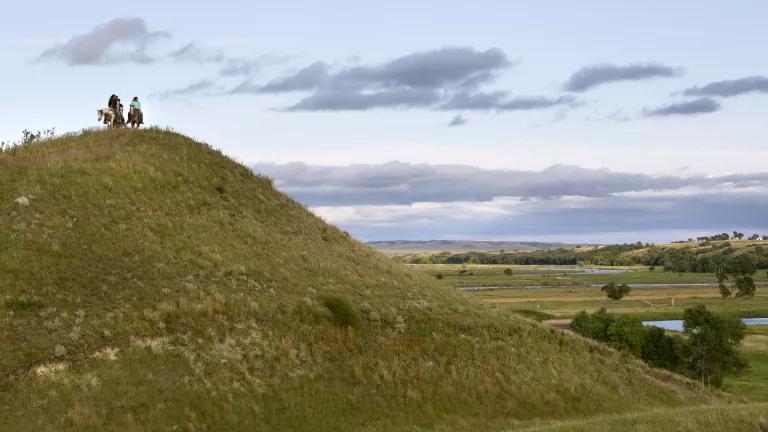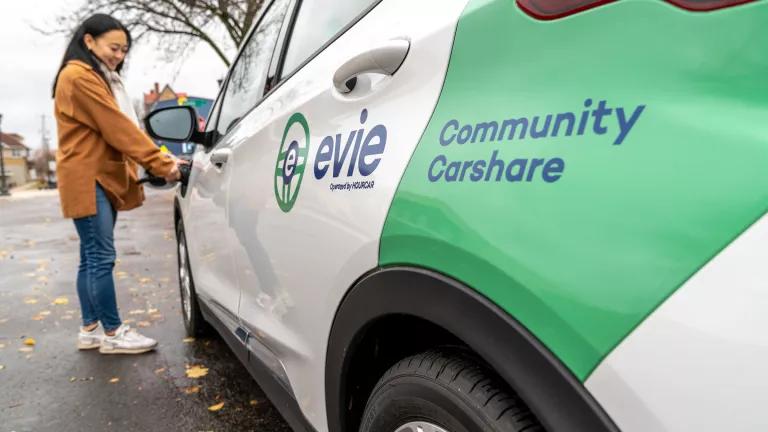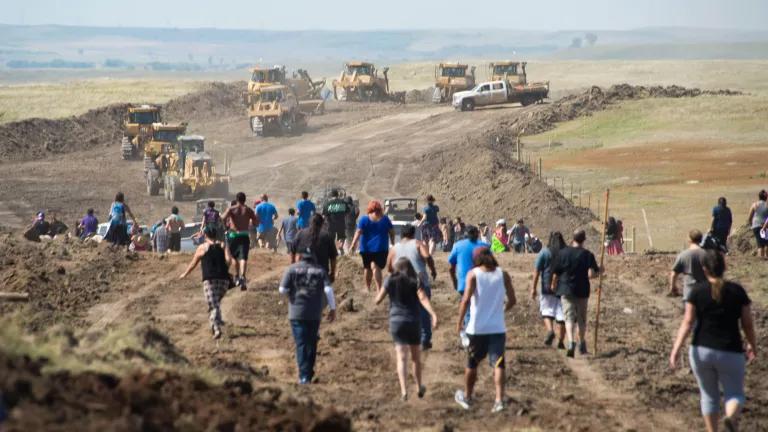Clean Transportation: Another Form of Indigenous Resistance to Big Oil
A deep dive into Tribal clean transportation with the executive director of Electric Nation, Bob Blake.

Electric Nation welcomes the arrival of electric vehicles for tribal fleets.
Courtesy of Bob Blake
An Indigenous-led initiative called Electric Nation is connecting 23 different Tribal nations in the Midwest and helping them further their opposition to the fossil fuel industry by building electric vehicle (EV) charging stations and increasing access to electric vehicles. The initiative—which launched earlier this year—is the brainchild of Bob Blake, a Tribal member of Red Lake Nation and a fierce advocate and leader in expanding access to clean transportation and renewable energy in Indian Country. Along with his position as executive director of Electric Nation, Blake is also the founder and CEO of both Solar Bear, a solar installation company, and Native Sun Community Power Development, a nonprofit that promotes education and workforce training on renewable energy in Indigenous communities.
Electric Nation is a $13.9 million project funded by grants from the U.S. Department of Energy (DOE) and by cost sharing among project partners that span across Tribes in Minnesota, North Dakota, and South Dakota. The goals of the project account for all necessary steps to increase access to EVs:
- Install 55 direct current fast-charging units on Tribal lands and connect them to main travel routes and other Tribal communities.
- Install 60 Level 2 EV supply equipment points at community gathering spots, including grocery stores, multifamily housing, Tribal colleges, casinos, and other destinations.
- Deploy EVs in Tribal fleets, including 16 light-duty EVs, an electric shuttle, and two electric school buses.
- Implement two workforce training programs for the members of Red Lake Nation and Standing Rock Sioux Tribe.
- Implement 52 educational sessions to communities about EV usage and benefits.

A map of Electric Nation's expansive charging network
Courtesy of Bob Blake
In a recent interview, Blake explains how Electric Nation came to be. While its official launch occurred in January 2024, the idea of Electric Nation was born years ago amid the opposition, protests, and legal battles of numerous Tribes to the Line 3 and Dakota Access pipelines. The two pipelines, which together cover more than 2,000 miles, faced backlash from the Tribal nations they crossed for violating treaty rights and threatening waterways, environmental health, and ancestral lands. “We just felt like there was almost this invasion of our homelands,” Blake says “It felt like we were being targeted. We thought to ourselves, They may have won the battle, but they're not going to win the war.”. He calls Electric Nation “a direct response” to the fossil fuel infrastructure that was built on Indigenous lands in the region. “[Electric Nation] was just another form of Native American resistance to the fossil fuel expansion and infrastructure,” he says.
Giving people a choice between fossil fuel–powered vehicles and clean ones is a point of emphasis for Blake, as is educating communities about the benefits of electric vehicles so that people can make better informed decisions. “We thought to ourselves, We're going to continue to fight the fossil fuel infrastructure with our own [infrastructure] and let people decide on what they feel is right for them,” he explains. “We felt like if we were able to give that choice to people, then ultimately, people are going to choose to move toward electric vehicles in the future.” Tribes have historically been left out of major energy transitions, which makes leaders who are working toward creating accessibility to clean transportation and energy, like Blake, especially important.
Electrification of households in the United States is one area in which Tribes have been historically excluded. Despite how often their lands are exploited for energy resources, Indigenous populations still face some of the highest energy disparities in the nation. The Rural Electrification Act of 1936 saw electrification in 85 percent of American homes by 1945. However, according to the Energy Information Administration, it wasn’t until more than 50 years later, in 2000, that 85 percent of Native households were electrified, due to a lack of federal funding and programs. Now, more than 20 years later, electrification in Indian Country is still behind the rest of the United States; as of 2021, more than 75 percent of unelectrified households in the country are located on Tribal lands. In addition, residents on Tribal lands pay 28.3 percent more for energy than the average U.S. citizen on average and are 6.5 times more likely to experience electricity outages per year. It is of utmost importance to ensure that this historical pattern of Tribes being left behind does not repeat itself in the transition to clean transportation, which is why initiatives like Electric Nation are vital to laying the groundwork for the changes ahead.

One of Electric Nation's educational booths
Courtesy of Bob Blake
Blake hopes the momentum from Tribal clean transportation access will extend beyond Indian Country and to rural America in general. “I think there's always been this disconnect between rural and urban and how the rural is going to come along in this green energy transition,” Blake says. “And I thought that this could be a perfect example of that happening—showing how rural America could be a part of the green transition too.” Electric Nation’s charging network is currently being built out, with many operational charging stations already running and in use by Tribal members. More than 75 percent of the planned Level 2 chargers have been installed at this point, and 16 electric vehicles have been deployed for Tribal use, including electric pickup trucks. This progress not only sets an example for other rural areas but also physically connects the expansive areas that the charging stations span, facilitating intertribal travel and bringing business into Tribal lands. Blake describes the future of Electric Nation as a new Route 66. “This ended up being an opportunity where folks could essentially see themselves driving this route, like Route 66. Putting people in the family electric vehicle and then driving this route.”
While the transition to clean energy and transportation is most definitely underway, fossil fuel interests still pose an active threat to our planet, Indigenous nations, and much more. Electric Nation serves as an example of yet another way that Indigenous Peoples are taking a stand against Big Oil. It is also evidence that the transition to clean vehicles is not just for urban communities, but it can reach rural America too. In the face of climate change, this transition is absolutely necessary, and Blake hopes he can help people to see that. “If we're really going to save this planet, if we're really going to save our environment, then we're going to have to switch to electric vehicles and other modes of non–greenhouse gas–emitting transportation. Because if we continue at the same pace, we're going to destroy the planet.”


